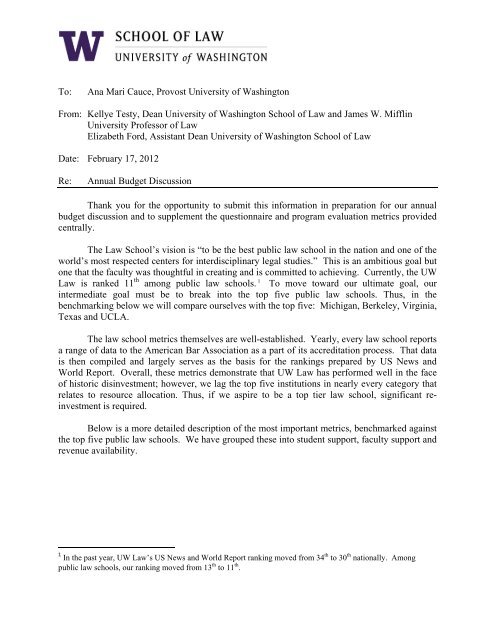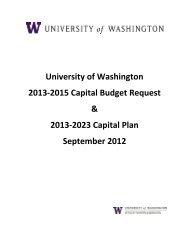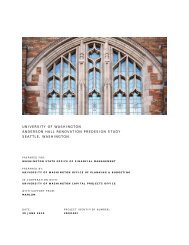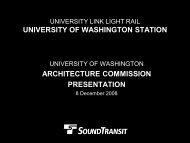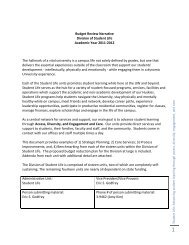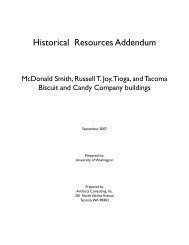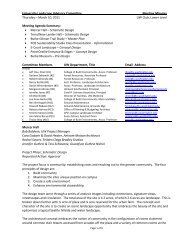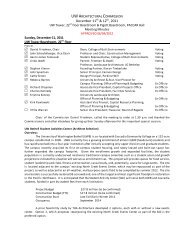Budget Memo Law 2 - Office of Planning & Budgeting (OPB ...
Budget Memo Law 2 - Office of Planning & Budgeting (OPB ...
Budget Memo Law 2 - Office of Planning & Budgeting (OPB ...
You also want an ePaper? Increase the reach of your titles
YUMPU automatically turns print PDFs into web optimized ePapers that Google loves.
To: Ana Mari Cauce, Provost University <strong>of</strong> Washington<br />
From: Kellye Testy, Dean University <strong>of</strong> Washington School <strong>of</strong> <strong>Law</strong> and James W. Mifflin<br />
University Pr<strong>of</strong>essor <strong>of</strong> <strong>Law</strong><br />
Elizabeth Ford, Assistant Dean University <strong>of</strong> Washington School <strong>of</strong> <strong>Law</strong><br />
Date: February 17, 2012<br />
Re: Annual <strong>Budget</strong> Discussion<br />
Thank you for the opportunity to submit this information in preparation for our annual<br />
budget discussion and to supplement the questionnaire and program evaluation metrics provided<br />
centrally.<br />
The <strong>Law</strong> School’s vision is “to be the best public law school in the nation and one <strong>of</strong> the<br />
world’s most respected centers for interdisciplinary legal studies.” This is an ambitious goal but<br />
one that the faculty was thoughtful in creating and is committed to achieving. Currently, the UW<br />
<strong>Law</strong> is ranked 11 th among public law schools. 1 To move toward our ultimate goal, our<br />
intermediate goal must be to break into the top five public law schools. Thus, in the<br />
benchmarking below we will compare ourselves with the top five: Michigan, Berkeley, Virginia,<br />
Texas and UCLA.<br />
The law school metrics themselves are well-established. Yearly, every law school reports<br />
a range <strong>of</strong> data to the American Bar Association as a part <strong>of</strong> its accreditation process. That data<br />
is then compiled and largely serves as the basis for the rankings prepared by US News and<br />
World Report. Overall, these metrics demonstrate that UW <strong>Law</strong> has performed well in the face<br />
<strong>of</strong> historic disinvestment; however, we lag the top five institutions in nearly every category that<br />
relates to resource allocation. Thus, if we aspire to be a top tier law school, significant reinvestment<br />
is required.<br />
Below is a more detailed description <strong>of</strong> the most important metrics, benchmarked against<br />
the top five public law schools. We have grouped these into student support, faculty support and<br />
revenue availability.<br />
1 In the past year, UW <strong>Law</strong>’s US News and World Report ranking moved from 34 th to 30 th nationally. Among<br />
public law schools, our ranking moved from 13 th to 11 th .
Page | 2<br />
STUDENT SUPPORT<br />
Annual <strong>Budget</strong> Discussion<br />
One <strong>of</strong> the important measures that the ABA tracks and U.S. News relies on is an<br />
institution’s monetary expenditure per student FTE. The figure below demonstrates that UW<br />
lags far behind in this measure:<br />
Our expenditure per student FTE in 2009-2010 was about half the amount provided by the<br />
number one public law school and $15,000 less per student than our nearest competitor. We<br />
have been working hard to move the needle on this by investing strategically in the areas that<br />
will provide the most important value to students: new faculty; admissions/financial aid; and<br />
career development. We have acted aggressively in these areas, particularly in our faculty and<br />
staff hiring. However, there is simply no way to be competitive with the top five institutions<br />
without significant, new investment.<br />
Even as we break this metric down into categories <strong>of</strong> support, UW <strong>Law</strong> lags far behind in<br />
nearly every category related to resource allocation.<br />
• Student Aid<br />
$74,231<br />
$67,016<br />
Michigan Cal.<br />
Berkeley<br />
Expenditure per Student FTE<br />
$60,118<br />
$53,378 $53,049<br />
$38,804<br />
Virginia Texas UCLA Washington<br />
Though we have made significant strides in student aid over the past two years, we are<br />
constrained by available resources. The figure below demonstrates the 2009 total <strong>of</strong> student<br />
grants and loans among the top five public law schools and the University <strong>of</strong> Washington. 2<br />
2 In 2010, the <strong>Law</strong> School made a significant investment in this area, exceeding the amounts available in gift funds.<br />
This put additional pressure on our tuition, state and fee‐based dollars. Though it was a considerable risk, it was<br />
one we felt was essential.
Page | 3<br />
$15,000,000<br />
$10,000,000<br />
$5,000,000<br />
$0<br />
Annual <strong>Budget</strong> Discussion<br />
Even taking into account the differences in student FTE at all institutions, UW <strong>Law</strong> aid is still on<br />
average about one third <strong>of</strong> the aid given at the top five public law schools.<br />
• Student Selectivity and Yield.<br />
Total Student Aid<br />
Because <strong>of</strong> the power <strong>of</strong> the UW <strong>Law</strong> brand, the attractiveness <strong>of</strong> the location and the<br />
connection to the University <strong>of</strong> Washington, UW <strong>Law</strong> has been able to maintain its selectivity<br />
and yield rates at 21% and 34%, respectively. This is virtually identical to our rates from 2010, a<br />
worthy accomplishment in the context <strong>of</strong> an overall decrease in applications regionally and<br />
nationally. 3 We also compare remarkably well in this area with the top five.<br />
19%<br />
10% 11%<br />
Selectivity<br />
Indications for the upcoming year are very positive. In the northwest, law school applications<br />
are down 19.6%. Nationally, applications are <strong>of</strong>f by 13%. Nonetheless, applications to UW <strong>Law</strong><br />
for the upcoming academic year are up by 10.6%.<br />
3<br />
In 2010 UW <strong>Law</strong>’s application rate remained unchanged, while the application rates nationally and regionally<br />
plunged by double digits.<br />
23%<br />
16%<br />
21%<br />
Michigan Berkeley Virginia Texas UCLA Univ.<br />
Wash.<br />
32% 33%<br />
Yield<br />
40%<br />
30%<br />
22%<br />
34%<br />
Michigan Berkeley Virginia Texas UCLA Univ.<br />
Wash.
Page | 4<br />
Annual <strong>Budget</strong> Discussion<br />
The two figures below demonstrate median GPA and LSAT for the 2010 entering class as<br />
compared with the top five. These student quality indicators are consistently lower than the top<br />
five, though they are within reach. The trick will be getting the top performers into our pool,<br />
which <strong>of</strong> course is related to our ranking and the availability <strong>of</strong> student aid.<br />
• Bar Passage Rate and Placement.<br />
Our measures <strong>of</strong> output compare very strongly with the top five, indicating that, in spite <strong>of</strong><br />
dramatic differences in financial investment, the quality <strong>of</strong> the pr<strong>of</strong>essional preparation is worthy<br />
<strong>of</strong> placement in the top tier <strong>of</strong> public law schools. As to bar passage rate, it is important to<br />
equalize for state-to-state differences in rates <strong>of</strong> passage. Thus, the chart below compares each<br />
<strong>of</strong> the top five on the basis <strong>of</strong> by how much each exceeds the overall state rate <strong>of</strong> bar passage.<br />
20%<br />
15%<br />
10%<br />
5%<br />
0%<br />
3.73 3.79 3.85<br />
Median GPA<br />
As to career development, again UW <strong>Law</strong> is right in the mix with the top five. Here, it is<br />
important to look at both the overall rate, but perhaps more importantly, the percentage <strong>of</strong><br />
3.71<br />
3.77<br />
3.66<br />
Michigan Berkeley Virginia Texas UCLA Univ.<br />
Wash.<br />
Median LSAT<br />
169 167 170 167 168<br />
163<br />
Michigan Berkeley Virginia Texas UCLA Univ.<br />
Wash.<br />
Pass Percentage Exceeding State Rate<br />
Michigan Berkeley Virginia Texas UCLA Univ.<br />
Wash.
Page | 5<br />
Annual <strong>Budget</strong> Discussion<br />
graduates who are both unemployed and seeking employment. 4 On that metric, our numbers are<br />
virtually identical to Berkeley, Texas and UCLA.<br />
96.8 95.6 98.8<br />
FACULTY SUPPORT<br />
92.8 93.9 89.5<br />
0 2 0 2 2 2<br />
Michigan Berkeley Virginia Texas UCLA Univ.<br />
Wash.<br />
The ABA tracks the amount each law school expends on salary for faculty. The figure<br />
below demonstrates total instructional expenditure by each institution. UW <strong>Law</strong> expends less<br />
than half the amount <strong>of</strong> its nearest competitor in instructional salaries.<br />
$19,652,032<br />
Placement Rate 2010<br />
Percentage Employed Unemployed Seeking Work<br />
Total Instructional Salary Expenditure<br />
$16,647,826<br />
$20,818,411 $19,267,771<br />
$15,045,000<br />
$7,129,669.00<br />
Michigan Berkeley Virginia Texas UCLA Univ. Wash.<br />
4 The ABA and US News counts students who are not seeking employment and those who are in graduate school as<br />
“unemployed.” Because we have a joint JD/LLM program, all <strong>of</strong> our students who move on to the LLM program<br />
are counted against our placement total. For that reason, a more true measure <strong>of</strong> students who are looking for<br />
work and unable to find it is the “unemployed seeking work” metric. If it is useful, we are able to break this metric<br />
down further into types <strong>of</strong> placement, full versus part time and the like.
Page | 6<br />
Annual <strong>Budget</strong> Discussion<br />
To account for differences in student body size, the figure below looks at instructional salary as a<br />
function <strong>of</strong> student FTE and demonstrates that if we were to make an enrollment jump too<br />
quickly, we would fall even further behind on this metric.<br />
$25,000.00<br />
$20,000.00<br />
$15,000.00<br />
$10,000.00<br />
$5,000.00<br />
$0.00<br />
Instructional Salary Per Student FTE<br />
Michigan Berkeley Virginia Texas UCLA Univ.<br />
Wash.<br />
A further measure <strong>of</strong> the commitment to faculty research can be seen in faculty summer salary<br />
support. Here we see an especially dramatic difference.<br />
$1,509,358 $2,064,490<br />
Summer Salaries<br />
$5,400,322<br />
$3,605,142<br />
$1,711,000<br />
$420,523<br />
Michigan Berkeley Virginia Texas UCLA Univ.<br />
Wash.<br />
Not surprisingly, an equally large issue for UW <strong>Law</strong> is faculty compensation. On average, our<br />
faculty members are paid about 65% <strong>of</strong> the salary received by faculty in the top three institutions.<br />
The figure below details those averages.<br />
Average Faculty Salary<br />
$191,726 $198,500 $183,814<br />
$123,520<br />
Michigan Berkeley Virginia Univ. Wash.
Page | 7<br />
Annual <strong>Budget</strong> Discussion<br />
As reported by the Seattle Times on February 2, 2012, the University <strong>of</strong> Washington has become<br />
a prime poaching ground for other institutions:<br />
Washington is now known as a place to go headhunting” for out-<strong>of</strong>-state<br />
universities hiring new faculty, said Bruce Shepard, president <strong>of</strong> Western<br />
Washington University. “This is a real threat, long term, to sustaining the<br />
excellence <strong>of</strong> our universities.<br />
We have experienced some effects <strong>of</strong> that just this year, losing two faculty members to<br />
competing institutions.<br />
Because <strong>of</strong> the small size <strong>of</strong> the student body, we have been able to remain quite<br />
competitive in the area <strong>of</strong> faculty-student ratio. 5 However, if we seek to increase enrollment<br />
capacity without negatively affecting ranking, we must anticipate the need to remain competitive<br />
in this area. Additionally, because one <strong>of</strong> our challenges is the peer ranking among other law<br />
schools, it is imperative to continue to grow a vibrant faculty with a national and international<br />
reputation.<br />
SOURCES OF REVENUE<br />
The total revenue available to UW <strong>Law</strong> is dramatically lower than the top five. This<br />
includes tuition, gifts, grants, other revenue and state support.<br />
$80,000,000<br />
$70,000,000<br />
$60,000,000<br />
$50,000,000<br />
$40,000,000<br />
$30,000,000<br />
$20,000,000<br />
$10,000,000<br />
$0<br />
Total Revenue Available<br />
5 Because each <strong>of</strong> the top five public law schools uses the semester system and not the quarter system, it is notpossible<br />
to do apples-to-apples comparison against the University <strong>of</strong> Washington since the semester-based systems<br />
generally are several points higher in the student/faculty ratio. So whereas the overall average among semesterbased<br />
programs is 14, the average among quarter-based programs is 11. UW <strong>Law</strong>’s student-faculty ratio is 9.7.
Page | 8<br />
Annual <strong>Budget</strong> Discussion<br />
As we break out each <strong>of</strong> these areas <strong>of</strong> revenue, the problems and solutions become much<br />
clearer. 6<br />
• Tuition.<br />
The chart below compares UW <strong>Law</strong>’s tuition levels with the top five. UW <strong>Law</strong>’s tuition<br />
affordability is a serious admissions advantage, particularly during this downturn. However,<br />
there is no question that in order to compete with the top five, we must slowly adjust our tuition<br />
level. The only question is how much and when.<br />
Michigan Berkeley Virginia Texas UCLA Univ. Wash.<br />
Resident $44,840<br />
Non-<br />
$44,244 $42,500 $28,669 $40,616 $24,339<br />
Resident $47,840 $52,245 $47,500 $44,638 $50,639 $37,229<br />
As we plan for careful movement here, it is important to look at tuition trends among the<br />
top five. The below figure demonstrates that the rate <strong>of</strong> increase in resident tuition has been<br />
about the same as the competitor institutions, with one difference: Berkeley’s tuition spiked in<br />
the last two years likely in response to state disinvestment. Facing the same disinvestment, UW<br />
<strong>Law</strong>’s has attempted to keep its tuition rate <strong>of</strong> increase about the same.<br />
Tuition<br />
50000<br />
45000<br />
40000<br />
35000<br />
30000<br />
25000<br />
20000<br />
15000<br />
10000<br />
5000<br />
0<br />
2001<br />
2002<br />
Resident Tuition 2001-2010<br />
2003<br />
2004<br />
2005<br />
6 This is the figure reported to the ABA in 2010, but it under-represents the total revenue available since it did not<br />
include some gift, grant and fee-based revenue. The correct number should be just over $20 million.<br />
2006<br />
2007<br />
2008<br />
2009<br />
2010<br />
Michigan<br />
Berkeley<br />
Virginia<br />
Texas<br />
UCLA<br />
Univ. Wash.
Page | 9<br />
Annual <strong>Budget</strong> Discussion<br />
In the area <strong>of</strong> non-resident tuition, UW <strong>Law</strong>’s rate <strong>of</strong> increase has been flatter than its<br />
competitors in the early years <strong>of</strong> the decade resulting overall in a widening <strong>of</strong> the gap between<br />
UW and the top five institutions.<br />
• Enrollment<br />
Tuition<br />
60000<br />
50000<br />
40000<br />
30000<br />
20000<br />
10000<br />
0<br />
UW <strong>Law</strong>’s overall enrollment in the JD program is significantly lower than the top five. The<br />
figure below demonstrates that difference in 2010.<br />
1117<br />
2001<br />
2002<br />
Non Resident Tuition 2001-2010<br />
944<br />
Michigan Cal ‐<br />
Berkeley<br />
2003<br />
2004<br />
2005<br />
2006<br />
2007<br />
2008<br />
2010 Enrollment<br />
1122<br />
2009<br />
2010<br />
Michigan<br />
Berkeley<br />
Virginia<br />
Nonetheless and in spite <strong>of</strong> the significant deficits in student aid, the <strong>Law</strong> School has made<br />
strides in this area, increasing overall enrollment since 2001 by 13% and minority enrollment by<br />
58%. 7 The figures below compare those results with our competitors. Over that 10-year period<br />
UW has expanded its enrollment at a higher rate than the top five institutions, though it is<br />
important to keep in mind that UW <strong>Law</strong> began with a smaller real number <strong>of</strong> enrollees.<br />
7 2001 was the year that Initiative 200 was enacted by the people <strong>of</strong> Washington and resulted in a significant dip in<br />
minority enrollment. Since then, UW <strong>Law</strong> has made steadily improved in our ability to attract diverse students.<br />
1182<br />
1011<br />
Texas<br />
UCLA<br />
Univ. Wash.<br />
550<br />
Virginia Texas UCLA Univ.<br />
Wash.
• Gifts<br />
Page | 10<br />
‐20%<br />
Univ. Wash.<br />
UCLA<br />
Texas<br />
Virginia<br />
Cal ‐ Berkeley<br />
Michigan<br />
Annual <strong>Budget</strong> Discussion<br />
4%<br />
5.7%<br />
4%<br />
The <strong>Law</strong> School has been breaking its own giving records year after year for the last several<br />
years; however, we have significant ground to make up to be competitive in the top five. The<br />
figure below describes the endowments held by each <strong>of</strong> the top five as compared with UW <strong>Law</strong><br />
$288,362,047<br />
Percentage Increase in Enrollment Since 2001<br />
Univ. Wash.<br />
UCLA<br />
Texas<br />
Virginia<br />
Berkeley<br />
Michigan<br />
Percentage increase in minority enrollment since 2001<br />
$207,976,524<br />
Though the amount <strong>of</strong> yearly giving is up and growing, the figure below compares our 2009-<br />
2010 gift revenue with the top five.<br />
23%<br />
23%<br />
Endowment Mkt Value<br />
$299,810,421<br />
$181,133,879<br />
27%<br />
6%<br />
35%<br />
34%<br />
13%<br />
$74,016,000 $70,894,544<br />
Michigan Berkeley Virginia Texas UCLA Univ. Wash.<br />
46%
• Grants<br />
Page | 11<br />
$7,128,555.00<br />
$5,053,034.00<br />
Annual <strong>Budget</strong> Discussion<br />
In the area <strong>of</strong> grant revenue, UW <strong>Law</strong> does extremely well, second only to Berkeley in the<br />
amount <strong>of</strong> revenue from training and research grants. Overall, however, this is a very small<br />
piece <strong>of</strong> the overall revenue picture.<br />
• Reserves<br />
Total Gift Funds<br />
$14,017,240.00<br />
$5,884,326.00<br />
$2,241,000.00 $2,608,545.00<br />
Michigan Berkeley Virginia Texas UCLA Univ. Wash.<br />
$1,509,086.00<br />
$4,071,668.00<br />
Total Grants<br />
$2,084,958.00<br />
$1,471,336.00<br />
$1,031,000.00<br />
$109,786.00<br />
Michigan Berkeley Virginia Texas UCLA Univ. Wash.<br />
Finally, in the area <strong>of</strong> reserves, UW has no operating reserve. Indeed, this area is one that<br />
distinguishes us most dramatically from our peers. The figure below shows reserve amounts in<br />
total dollars. While this does not directly affect ranking, it does place us in a precarious situation.
Page | 12<br />
$24,730,845.00 $24,730,845.00<br />
$39,590,617.00<br />
Reserves<br />
$34,826,928.00<br />
RE-INVESTMENT IN UW LAW<br />
Annual <strong>Budget</strong> Discussion<br />
$‐ $‐<br />
Michigan Berkeley Virginia Texas UCLA Univ. Wash.<br />
While we would like to begin by asserting our ability to make the shift in national<br />
prominence without additional assistance from the University, we cannot do that. An initial<br />
investment in the <strong>Law</strong> School is required to maintain the initial momentum.<br />
The <strong>Law</strong> School has moved aggressively over the past two years to demonstrate that it<br />
can be competitive as a top tier law school. To accomplish that, the <strong>Law</strong> School has invested<br />
heavily in faculty hires which have moved our US News and World Report Peer Assessment<br />
score from 3.1 to 3.2. More to the point, however, these faculty hires have rejuvenated and<br />
inspired our faculty to perform in ways that are more impressive and collegial than they have<br />
been in decades. 8 Nonetheless, we have lost two faculty members this year to other institutions<br />
and fear that we may lose more in the coming years. For that reason, we have hired two<br />
additional faculty members for the upcoming year and will likely hire a Director for our Asian<br />
<strong>Law</strong> Center.<br />
We have also invested in staff in key areas including admissions and career development.<br />
These areas are essential to our success and had been terribly neglected before my arrival. All <strong>of</strong><br />
this work has taken a significant financial investment and as a result, we are outside <strong>of</strong> our<br />
budgeted amounts in most areas <strong>of</strong> salary. We knew that this was a risk and one that we expect<br />
will pay dividends.<br />
8 Our newest faculty additions, Zahr Said and Sanne Knudsen have continued on this path providing outstanding<br />
teaching and, even in the first quarter <strong>of</strong> her time with use, Pr<strong>of</strong>essor Knudsen has two articles committed to<br />
publication in the area <strong>of</strong> environmental law.
Page | 13<br />
Annual <strong>Budget</strong> Discussion<br />
To continue to move in the right direction, we will be seeking an additional investment in the<br />
following areas:<br />
- Student Aid. While we work toward more robust endowments in the scholarship area,<br />
we must attract elite students into our pool and maintain accessibility to those students<br />
who would not otherwise be able to consider law school. To do that, we must be in a<br />
position to <strong>of</strong>fer the kind <strong>of</strong> aid that these students will expect in order to motivate them<br />
to place UW <strong>Law</strong> in their top tier <strong>of</strong> choices.<br />
- Faculty Support. We will be seeking three things in this area.<br />
o First, we will be seeking funding for additional faculty salaries sufficient to allow<br />
us to continue to build on the momentum the law school has generated thus far.<br />
o Second, we will be seeking additional support for faculty research in the form <strong>of</strong><br />
support for summer salaries.<br />
o Third, we will be seeking to fund a parity adjustment for our existing faculty. As<br />
we have added faculty over the last two years, it has become clear that our current<br />
group has fallen far behind the market. As the result, in order to recruit quality<br />
faculty we have exposed issues <strong>of</strong> compression and in some cases salary inversion<br />
among our existing faculty.<br />
We appreciate the opportunity to provide this additional information and lay out our<br />
plans for the coming years. We look forward to discussing this in more detail at our meeting in<br />
March. In the meantime, we are happy to answer any questions that you may have.


